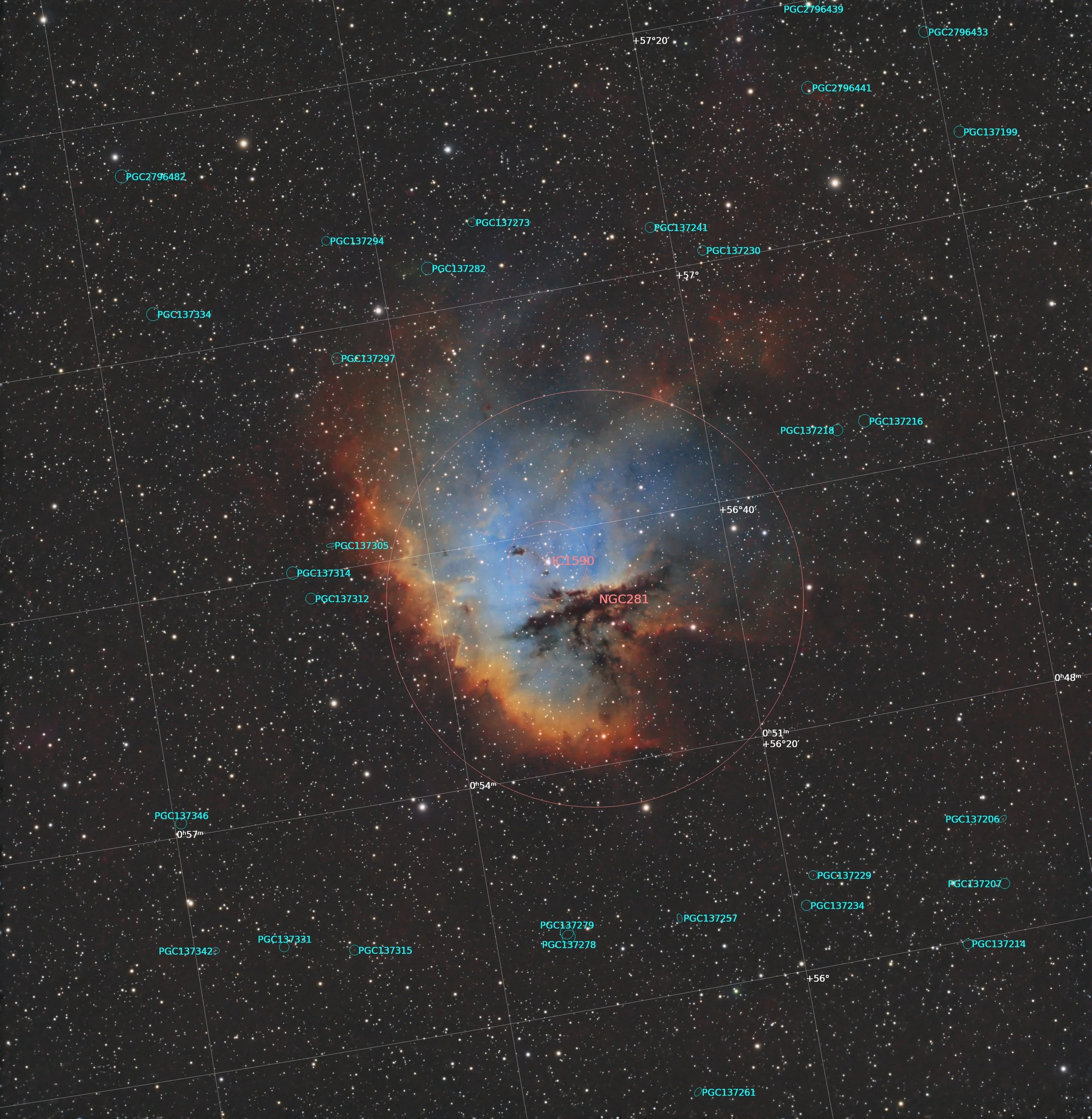NGC 281 - The Pacman Nebula in SHO (Hubble Palette)
NGC 281 is an HII region located about 10,000 light-years from Earth in the constellation Cassiopeia. With a diameter of about 100 light-years, it is part of the Perseus Arm. It includes or is close to the open cluster IC 1590, the double star HD 5005, and several Bok globules. It is visible with an amateur telescope in areas where the night sky is sufficiently dark.
Such a region usually appears spherical, with the energy source in the centre. With NGC 281, however, about a quarter of the nebula is hidden by dust clouds that are in the foreground. This creates its unusual appearance that is both photographically and visually striking, which reminded astronomers in the 1980s of a famous computer game character, giving this small object the commonly-used nickname the Pacman Nebula.
This emission nebula was discovered by American astronomer Edward Barnard in 1881. Barnard likely observed the same nebula in 1890, and it was later listed in the IC catalog as IC 11.
On 26 November 1881, the American astronomer Edward Emerson Barnard encountered a small gas nebula in the constellation of Cassiopeia. He was actually looking for comets whose discovery was rewarded with a prize of 200 dollars, which would be equivalent to 4 400 dollars today. He described his discovery as a faint, diffuse nebula, no more than 10 arc minutes across. It was named NGC 281, its central star cluster was named IC 5090.
Basic Facts
Object Type : Emission nebula with embedded open cluster
Constellation : Cassiopeia
Apparent Size : ~35 arcminutes
Other Designations : IC 11, Sharpless 184
Structure and Features
IC 1590 : A young open star cluster at the heart of the nebula, which ionizes the surrounding gas.
Bok Globules : Dense, dark regions of dust where new stars may be forming.
Bright Emission : The glow comes from ionized hydrogen gas (H II region), primarily excited by ultraviolet light from young, massive stars.
For Amateur Astronomers
Visibility : Best viewed from the Northern Hemisphere in autumn.
Telescope Required : A medium-to-large telescope or long-exposure astrophotography is ideal to capture details.
Coordinates:
Right Ascension : 00h 52m
Declination : +56° 37′
Set up
Fra400 on AVX mount
ASI533 MC Pro camera for imaging
ASI120 mini camera for guiding via OAG Zwo
Control via ASIAIR PLUS
Gain (ISO) : 101
Camera cooling : -10°C
Preprocessing and processing : Pixinsight
The session
NGC 281 was taken in April 29th, June 29th & July 4th 2025
28 images of 15 minutes each, broken down as follows :
Antlia Duoband (HO) 5 nm : 9 images
Askar D1 (HO) 6 nm : 7 images
Askar D2 (SO) 6 nm : 12 images
Total integration : 7 hours
The plan was to use only the Askar D1 and D2 filters, but one evening, I had the Antlia in the filter holder because I was shooting in the first part. evening M16 (Eagle Nebula). Once inaccessible and immersed in the depths of turbulence, rather than waste a few precious hours, I preferred to shoot with it on the Pacman. I thought, why not ? It can be a good exercise in handling and combining multiple filters during processing.
Procedure via PixInsight :
Calibration and stacking of images
Alignment of the 3 image files using Star Align
Dynamic crop to remove artifacts present in the corners of the 3 image files.
Split the R G B (Red, Green, Blue) channels respectively :
Antlia: R G B then renamed as follows: H1 O1 O2
Askar D1: RGB as follows: H2 O3 O4
Askar D2: RGB as follows: S O5 O6
S (Sulfur) layer on the red channel
I added H1 and H2 (Hydrogen Alpha) to create the layer on the green channel.
I removed the blue channels (O2, O4, and O6) because they were noisy and had low signal.
I took 1/3 of O1, O3, and O5 (green channel) to create the O (Oxygen III) layer on the blue channel using Pixelmath.
Assembly into a single image using channel combination
Gradient Correction to remove all the dirt due to light pollution present in the background.
BlurX Terminator to eliminate halos and correct stars
Quick stretch with Bill Blanshan's script
NoiseX Terminator
Correct magenta stars
StarX Terminator to remove the stars
Narrowband Normalization by choosing SHO, in "preserve" mode, I boosted Oxygen 3 and Sulfur & SCNR (Green Noise) to 0.50
Color mask: YELLOW & BLUE with 3 blurmask passes, then Curve each time for color & saturation
GHS (Generalised Hyperbolic Stretching) to adjust the background
Range Selection to refine.
Range selection was useful for two things: "Show mask" and "Invert mask" to desaturate, refine the background, and also play with the nebula to give it a little more brightness
Dark Structure Enhance to bring out the dark details of the nebula
Luminance Extraction
Stars reintegration
The procedure in video
The Pacman in Hubble palette version
Astrometry : Annotated version
Clear Sky !
Leave a comment

